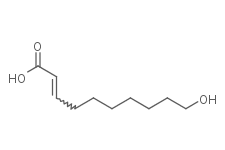
10-Hydroxy-2-decenoic acid
CAS No. 14113-05-4
10-Hydroxy-2-decenoic acid ( —— )
Catalog No. M18005 CAS No. 14113-05-4
10-Hydroxy-2-decenoic acid is an inhibitor of VEGF-induced angiogenesis, cell migration and proliferation.
Purity : 98%
 COA
COA
 Datasheet
Datasheet
 HNMR
HNMR
 HPLC
HPLC
 MSDS
MSDS
 Handing Instructions
Handing Instructions
| Size | Price / USD | Stock | Quantity |
| 50MG | 39 | In Stock |


|
| 100MG | 56 | In Stock |


|
| 500MG | 133 | In Stock |


|
| 1G | Get Quote | In Stock |


|
Biological Information
-
Product Name10-Hydroxy-2-decenoic acid
-
NoteResearch use only, not for human use.
-
Brief Description10-Hydroxy-2-decenoic acid is an inhibitor of VEGF-induced angiogenesis, cell migration and proliferation.
-
Description10-Hydroxy-2-decenoic acid is an inhibitor of VEGF-induced angiogenesis, cell migration and proliferation.
-
Synonyms——
-
PathwayMicrobiology/Virology
-
TargetHIV
-
RecptorOthers
-
Research Area——
-
Indication——
Chemical Information
-
CAS Number14113-05-4
-
Formula Weight186.25
-
Molecular FormulaC10H18O3
-
Purity98%
-
Solubility——
-
SMILESC(CCC/C=C/C(=O)O)CCCO
-
Chemical Name——
Shipping & Storage Information
-
Storage(-20℃)
-
ShippingWith Ice Pack
-
Stability≥ 2 years
Reference
1. Yang XH, et al. Comparative proteomic analysis provides insight into 10-hydroxy-2-decenoic acid biosynthesis in honey bee workers. Amino Acids. 2017 Apr 17.
molnova catalog


related products
-
HAR-171
HAR-171 is a small molecule gp120-CD40 blocker that acts as a highly potent HIV entry inhibitor with IC50 of 0.43 uM against YTA48P virus.
-
DAPTA
DAPTA is a synthetic peptide, functions as a viral entry inhibitor by targeting selectively CCR5, and shows potent anti-HIV activities. DAPTA potently inhibits specific CD4-dependent binding of gp120 Bal (IC50 = 0.06 nM) and CM235 (IC50 = 0.32 nM) to CCR5.
-
Diphyllin
Diphyllin could be characterized as a new V-ATPase inhibitor in treating gastric cancer and inhibiting the phosphorylation of LRP6 in Wnt/β-catenin signaling.



 Cart
Cart
 sales@molnova.com
sales@molnova.com


